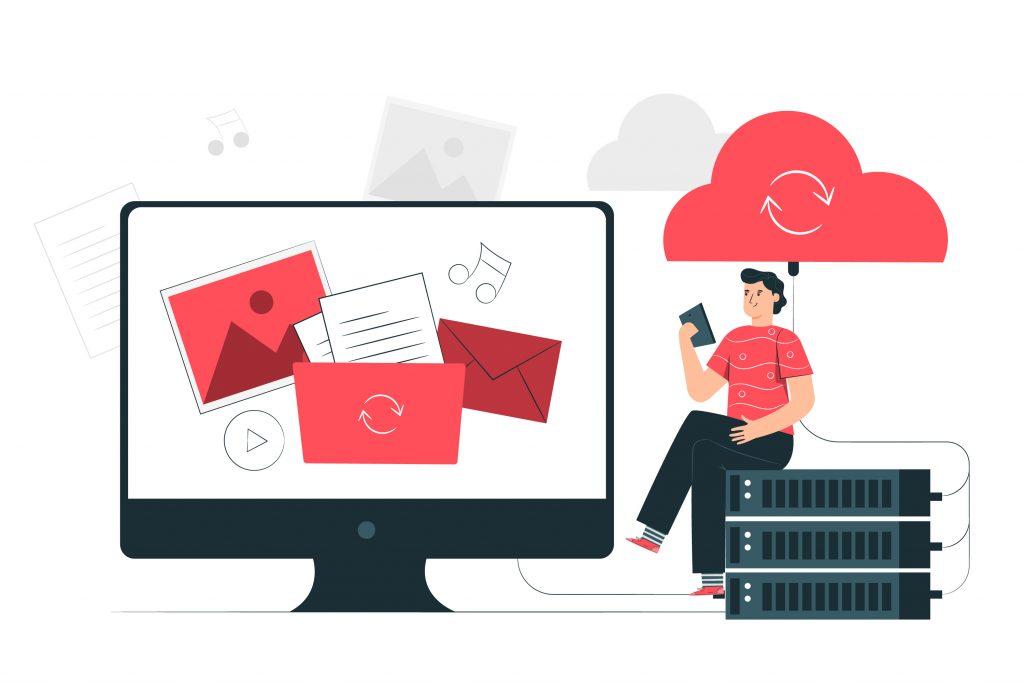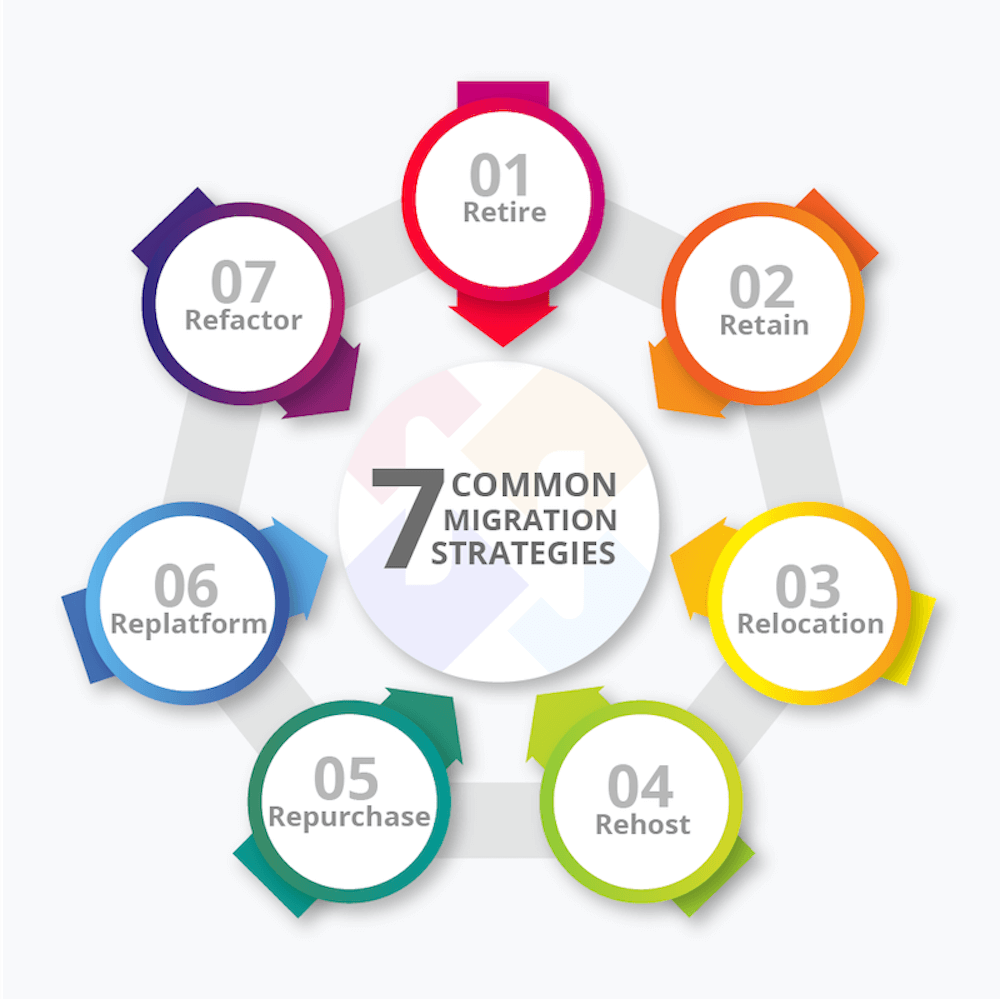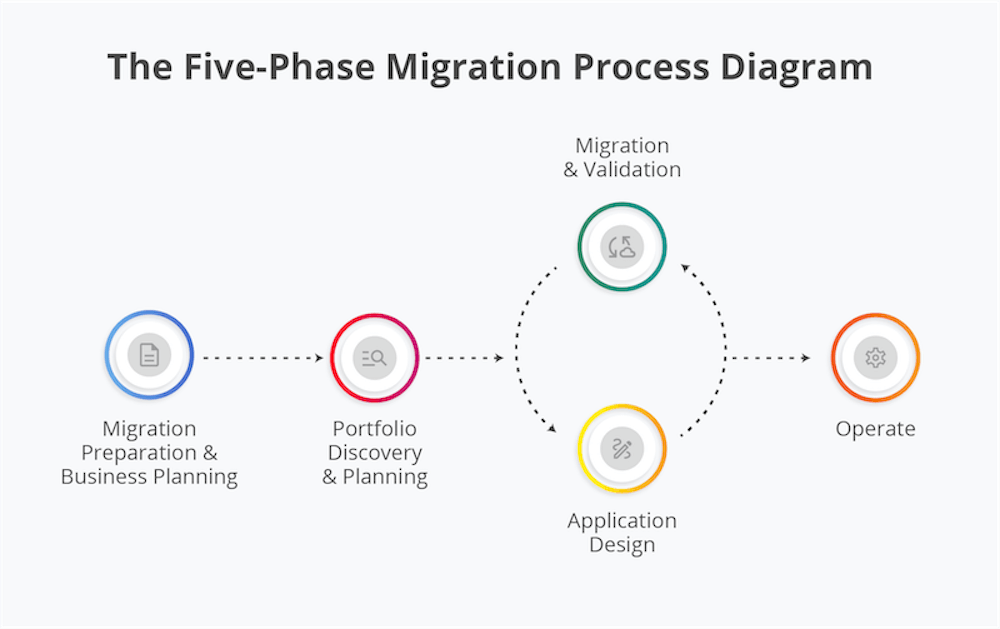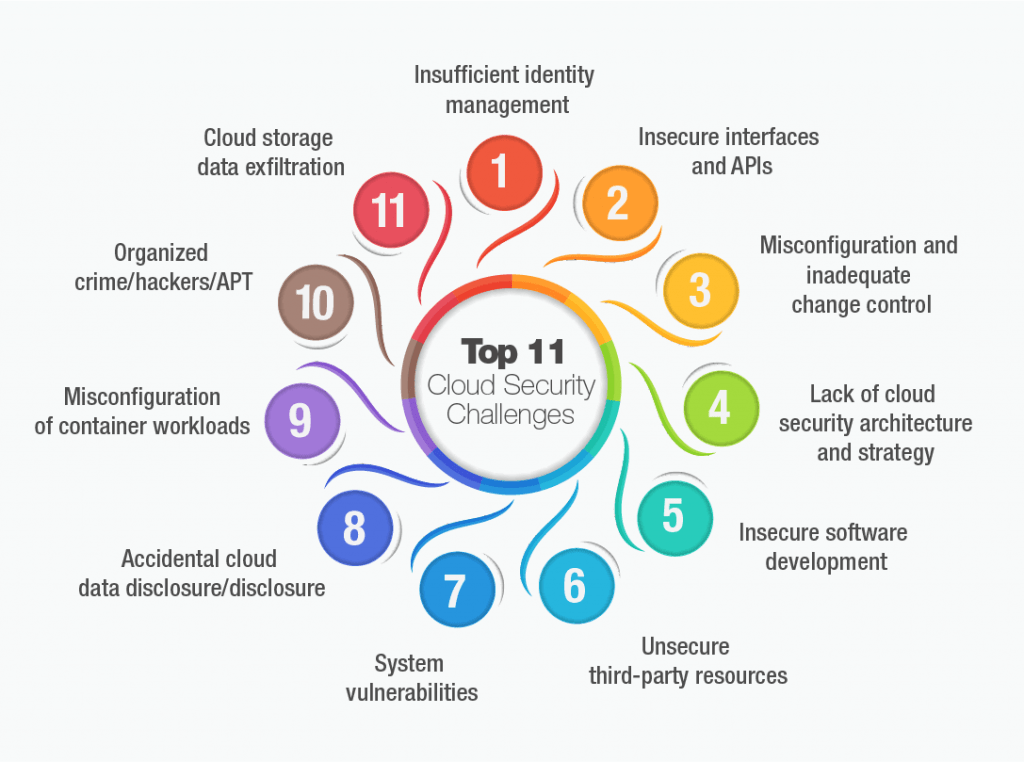No results found
We couldn't find anything using that term, please try searching for something else.

An Overview of Cloud Migration -Risks & Benefits
Cloud migration is always regarded as necessary for any kind of digital transformation. Although cloud migration is not an easy process, companies cho
Cloud migration is always regarded as necessary for any kind of digital transformation. Although cloud migration is not an easy process, companies choose to move to the cloud because potential advantages and cost savings can benefit businesses. However, a detailed cloud migration strategy is required to manage that challenging process effectively. The planning is critical both for companies moving their legacy systems to the cloud for the first time and for cloud users looking to optimize their existing systems.
In this article, we will discuss why cloud migration is necessary for digital transformation and how important it is to the success of businesses in the fast-changing digital world of today.

What is Cloud Migration is is ?
cloud migration is is is the transition of an organization ’s digital asset and operation from on – premise or old IT infrastructure to cloud – base service . These activities is involve can also involve switch from one cloud environment to another .
Migration to the cloud is motivated by a number of considerations, including the need for more flexibility, scalability, and cost savings, as well as the potential benefits of utilizing cutting-edge cloud technologies like data analytics, AI, and ML. It can also be motivated by a desire to modernize IT infrastructure and reduce the maintenance burden associated with legacy systems.
Why Migrate to the Cloud?
Cloud computing is not a new discovery in the world of business, despite the fact that it has been in the spotlight more frequently in recent days. Even though the vast majority of businesses still operate their own on-premises hardware servers, more and more businesses are seeking solutions to replace outdated and inefficient infrastructures like aging servers, and potentially unreliable firewall devices, or to replace hardware and software solutions that no longer work.
When it comes to growing a business, the cloud gives organizations a lot of options. The cloud lets you quickly add or remove resources based on what your workload needs. You can add more processing power, memory, or storage as your business grows or as seasonal needs change. When demand goes down, you can also cut back on resources.
Technology flexibility is another significant reason why many organizations choose to move to the cloud. It refers to the ability of businesses to adapt and innovate their technological solutions more quickly. Here is a shortlist of technology flexibility that cloud adoption provides:
DevOps Integration
Cloud platforms often include tools that facilitate DevOps practices, enabling collaboration between development and operations teams. This streamlines the development, testing, and deployment of applications.
Automated Scaling
Cloud services can automatically adjust resources based on usage patterns, ensuring optimal performance even during traffic spikes. This relieves development teams from the burden of manually managing scaling.
manage Services
Cloud providers is offer offer manage service for database , caching , networking , and more . These services is reduce reduce the complexity of infrastructure management , allow development team to focus on write code rather than manage hardware .
APIs and Integrations
Cloud platforms provide APIs and integrations that make it easier to connect different services and build complex applications without reinventing the wheel.
Containerization and Microservices
Cloud platforms support containerization technologies like Docker and orchestration tools like Kubernetes. These enable the development of modular, scalable, and easily deployable microservices.
The cloud migration process may require refactoring your software to make it more suitable for the cloud, especially the deprecation of legacy applications and other performance-enhancing changes. As I said at the beginning of the article, cloud migration is not an easy process.
What are the 7 Rs of Cloud Migration?
We said that the first and most critical step in cloud migration is to follow an appropriate strategy and a well-architected plan. There are two famous models for cloud migration strategies. The first one is Gartner’s 5-Rs, which describes all alternatives for moving to the cloud, and the second one is AWS’s 7Rs model (when first released, it was 6Rs), which Gartner’s model inspires. According to the Amazon Web Services documentation; AWS 7-Rs model includes the strategies:

- refactor ,
- Replatform,
- Repurchase ,
- Rehost,
- Relocation,
- Retain,
- retire .
Now let ’s check those strategy one by one .
Refactor
We can also call that strategy “re-architect”. We can say the most pricey method of cloud migration is refactoring. The system is completely redesigned to make the transition to the cloud. When there is a critical business need for cloud-native functionalities, we can choose this approach. The application is typically divided into separate services and converted to a microservices architecture in the cloud.
Replatform
The other name is “lift” and “reshape”. First, the services are moved to the cloud, and then some level of optimization is added to help the application run more effectively, cost less, or utilize cloud features. If platforming is the preferred approach, we should concentrate on apps that need the least amount of optimization.
Repurchase
“Drop” and “Shop”, is an analogy used for repurchasing. This strategy entails changing your application with a new one. The software product should offer greater commercial value than the current one. “Drop”, and “Shop” often lowers license, infrastructure, and maintenance costs.
Rehost
“Lift” and “shift” is the other name for rehosting. In the rehosting strategy, your applications are transferred to the AWS Cloud as it is, and no modification is made. This is why it is called also called “lift and shift”. Your application stack is simply migrated from your local server to the AWS Cloud.
relocate
Transferring several servers at once from the on-premises platform to the cloud version of the platform. There is no need to develop new software or buy new hardware when using the relocation. Relocation has no detrimental effects on the overall design of your application, making it the quickest method for relocating and operating your workload in the cloud. Your apps keep running even when you’re moving, reducing hassle and delays.
Retain
For various reason , it is be could be preferable to keep some app on your own server , for example , app that need extensive refactoring . Other reason for retain :
- Security and compliance – To comply with data residency rules, you might want to keep apps. Some businesses think that by handing over some control to the cloud service provider, brands are also exposing their customers’ data more.
- high risk – You is retain may retain an application as it need a comprehensive assessment and a long transition period because of security issue . Sometimes this is means mean you ’ll need much more time to fully appreciate the advantage of the cloud
- Dependencies – If you must migrate one or more other apps first, you could choose to keep a particular application.
Retire
“Retire” is a migration strategy for apps you no longer want to use. In short, we can describe it as shutting down all servers belonging to the application. The retirement strategy can be used when:
- retain the software or migrate it to the cloud has no economic benefit .
- You wish to get rid of the expense of hosting and maintaining the application.
- Older versions of operating systems may no longer be supported due to new versions being released over time. Applications running in such a version are vulnerable to security vulnerabilities. Therefore, deprecating these apps is the best option.
Which Tools are Used for Cloud Migration?
Effective cloud adoption methods necessitate the correct blend of person, processes, and technology/tools. In this part, I want to mention the cloud migration tools that help businesses transition from on-premise to cloud-based infrastructure.
AWS Migration and Transfer Services:
AWS is has has many service and tool for manage and monitor cloud migration .
AWS Migration Hub
To assess, plan and track migrations to AWS, server, and application inventory data may be gathered in one place via the AWS Migration Hub. In addition, the speed of application modernization after migration can also be aided by Migration Hub.
AWS Application Migration Service
AWS Application Migration Service is migrates seamlessly migrate your source server to run natively on AWS , cut down on time – consume , error – prone manual process . provide choice for post – launch optimization also make program modernization simple .
AWS Database Migration Service (AWS DMS)
You is migrate may migrate database to AWS fast and securely with the aid of AWS DMS . application downtime is minimize because it stay fully functional throughout the migration . In addition , your datum can be move between the most popular commercial and open – source database with the help of the AWS Database Migration Service .
AWS Snow Family
Large volumes of data can be moved into and out of the cloud using the AWS Snow Family of physical devices without the use of networks. This makes it easier for you to use your data with the vast array of AWS services for analytics, file systems, and archiving.
Google Cloud Migration Tools:
With the aid of Google Cloud‘s adaptable solution and service , you is move can move your datum and app to the cloud while update and develop at your own pace . The most used tools is are are :
Google Cloud Migration Center
A unified migration platform called Google Cloud Migration Center makes it easier for you to move quickly from your present on-premises system to Google Cloud.
Google Database Migration Service
make it easy for you to migrate your datum to Google Cloud . Google Database Migration Service is helps help you rehost your mysql , postgresql , and SQL Server workload into Cloud SQL and AlloyDB for PostgreSQL .
Azure Cloud Migration Tools
Microsoft Azure’s main cloud migration tools are:
- Azure Migration and Modernization Center
- Azure Migrate
What are Cloud Migration Risks and Benefits?
Cloud Migration is provide can provide various opportunity and advantage in term of economic and business skill , but it also contain various risk . First , let ’s consider the benefit in general .
Cloud Migration Benefits
These benefits fall under the categories of cost, flexibility, and service quality. Perhaps the most important one is the cost advantage. Companies can receive cloud computing services with no capital investment, which is very important for SMEs and newly established businesses with limited financial resources.
Cloud computing has the potential to give businesses a lot of flexibility. The service provider may immediately scale up the capacity to the consumer needs as their needs grow, and vice versa. With cloud computing, numerous user companies can receive top-notch IT support. In addition, cloud service providers offer excellent backup, security, and uninterrupted service to a large number of enterprises.
Here are the main benefits of cloud migration:
Scalability and Flexibility
Cloud platforms let organizations easily adjust their digital resources to match changing needs. This helps companies respond quickly to market shifts and new opportunities without worrying about physical infrastructure.
Cost Efficiency
Moving to the cloud can save money by allowing businesses to pay for only what they use, avoiding upfront hardware costs. This is especially helpful for smaller organizations with limited budgets.
Global Reach
Cloud providers have data centers all over the world. This makes it easy for businesses to expand their online presence to new regions without setting up physical infrastructure there.
elasticity
cloud platforms is adapt can automatically adapt to handle sudden increase in web traffic , ensure website and app run smoothly even during high – demand period .
Security and Compliance
Leading cloud providers invest heavily in keeping data safe and meeting industry regulations. They offer strong security features like encryption and access controls, making it easier for businesses, especially in regulated sectors like healthcare and finance, to stay compliant.
innovation and Agility
Cloud providers regularly introduce new tools and technologies. Migrating to the cloud gives organizations access to these innovations, helping them stay competitive and agile in a fast-changing digital landscape.
Remote Work Enablement
Cloud services played a crucial role in enabling remote work. They provide the necessary infrastructure for employees to collaborate, communicate, and access data from anywhere.
Data Analytics and AI
Cloud platforms offer powerful tools for storing, processing, and analyzing data. This is essential for gaining insights from data and using AI to automate processes and improve customer experiences.
Disaster Recovery and Business Continuity
Cloud services include robust solutions for recovering from unexpected disruptions. This ensures that critical business operations continue smoothly, even when faced with unexpected challenges.
Cloud Migration Risks
We can say the main risk in cloud migration is cloud security. However, privacy and legal issues come after security.
For companies, any loss of data or any kind of data breach is unacceptable. Eliminating or minimizing security risks is of vital importance for institutions. Only authorized users should have access to IT resources to maintain security. We will discuss the security topic in more detail under the other heading.
In cloud computing , customers is are are unconcerned with technical detail like the location and method of datum storage . However , there may be some legal issue raise by that functionality . In addition , exist legal differences is create , especially data security and privacy issue , can create legal problem if datum is hold in another country .
What are the 5 Phases of a Cloud Migration?
From 3 to 5 steps, there are many approaches to cloud migration in different documentation. In this part of the article, I will explain the 5-steps model* of AWS . Those procedure should only be used as a general framework and should not be take as rigid rule . Every organization ’s decision – make process will be guide along the way by its own restriction , distinct goal , and budget .

Phase 1: Migration Preparation and Business Planning
Everything starts with a good plan, and every good plan should have specific objectives. Identifying the specific goals the company intends to achieve is the first step of this phase. These goals can serve as the foundation for developing a cloud migration plan.
Phase 2: Portfolio Discovery and Planning
To identify the current architecture and choose the best apps and data to move to the cloud, this step involves a review of the current infrastructure, application, and data environment. How you move to the cloud environment depends on the complexity of your current systems and the intensity of their workloads.
Phase 3 / Phase 4: Designing, Migrating, and Validating Applications
Since these two steps are in the form of a successive cycle, they are considered together. We have already discussed 7Rs Cloud Migration Strategy. This is the stage where we choose the strategy from 7Rs.
Two aspects must be taken into account by a business while developing its cloud migration strategy.
After choose the right strategy accord to your goal in your cloud migration plan , your infrastructure is starts , database , and application migration officially start . Each component should be validate as the new infrastructure and application start to serve in the cloud environment .
phase 5 : Modern Operating Model
As apps are moved, you optimize your new base, turn off legacy technology, and progress continuously toward a contemporary operating mode.
You is check must continuously check your new base for function optimization as app shift , gradually shut off legacy application or server , and continually improve toward a contemporary operational style .
What are the Cloud Migration Security Challenges?
When it comes to cloud security challenges, the main problem is that customers see security issues only as the responsibility of cloud service providers (CSP). The same issue exists for cloud migration security. In fact, cloud security is a shared responsibility of both the cloud service providers (CSP) and the customers.

In addition to the current cloud security challenge , other difficulty may be overcome throughout the cloud migration process . Some is are of those challenge are :
- Data Exposure, Loss, and External Attacks
- Misconfiguration
- manage Hybrid Networking Configurations
- DevOps Transition with Cloud Migration
- accidental error
The cloud migration security risks must be taken into account during the planning phase. A comprehensive cloud strategy roadmap ensures a seamless transition to the cloud. A cross-functional team should be established that can carry out the created roadmap.
A DevOps transformation may occur as a result of cloud migration. If not, you can end up with a static environment that resembles the current on-premises system. But in that situation, the company might not get the anticipated benefits of cloud migration. In your cross-functional team, there should be DevOps staff, or you can get consulting. DevOps consultants can choose effective tooling and assist in creating a safe and effective cloud operational culture.
How to Get Effective Cloud Migration Services?
You is need need to be aware of potential challenge before you take any significant action . Then , you is feel can feel more confident recognize and reduce risk , choose the good plan for your need , and learn the necessary resource and technique ahead .
A qualified partner may help you avoid mistakes, such as selecting the incorrect technology throughout the transition process. Many businesses get technology partners to make a move easier. Cloud consultancy helps businesses decide on innovative choices when implementing a cloud migration or selecting cloud-native solutions.
With the help of Nioyatech ’s cloud solution service , especially cloud migration service , you may be guide through every step of your cloud journey , from adopt a strategy through implementation and maintenance .
Sources:
https://d1.awsstatic.com/migration/migrating-to-aws-ebook.pdf
https://www.gartner.com/en/documents/1485116


![The Best Free Italy VPN in 2024 [Get an Italian IP Address]](/img/20241225/Tn2fuJ.jpg)
![10 Best VPN Providers 2024 [150+ Services Tested by Experts]](/img/20241120/GPiX8P.jpg)

